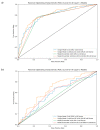Ensemble of Deep Recurrent Neural Networks for Identifying Enhancers via Dinucleotide Physicochemical Properties
- PMID: 31340596
- PMCID: PMC6678823
- DOI: 10.3390/cells8070767
Ensemble of Deep Recurrent Neural Networks for Identifying Enhancers via Dinucleotide Physicochemical Properties
Abstract
Enhancers are short deoxyribonucleic acid fragments that assume an important part in the genetic process of gene expression. Due to their possibly distant location relative to the gene that is acted upon, the identification of enhancers is difficult. There are many published works focused on identifying enhancers based on their sequence information, however, the resulting performance still requires improvements. Using deep learning methods, this study proposes a model ensemble of classifiers for predicting enhancers based on deep recurrent neural networks. The input features of deep ensemble networks were generated from six types of dinucleotide physicochemical properties, which had outperformed the other features. In summary, our model which used this ensemble approach could identify enhancers with achieved sensitivity of 75.5%, specificity of 76%, accuracy of 75.5%, and MCC of 0.51. For classifying enhancers into strong or weak sequences, our model reached sensitivity of 83.15%, specificity of 45.61%, accuracy of 68.49%, and MCC of 0.312. Compared to the benchmark result, our results had higher performance in term of most measurement metrics. The results showed that deep model ensembles hold the potential for improving on the best results achieved to date using shallow machine learning methods.
Keywords: biocomputing; dinucleotide physicochemical properties; enhancer DNA; ensemble deep learning; gene expression; high performance; transcription factor.
Conflict of interest statement
The authors declare no conflict of interest.
Figures





Similar articles
-
Predicting enhancers with deep convolutional neural networks.BMC Bioinformatics. 2017 Dec 1;18(Suppl 13):478. doi: 10.1186/s12859-017-1878-3. BMC Bioinformatics. 2017. PMID: 29219068 Free PMC article.
-
Integrative machine learning framework for the identification of cell-specific enhancers from the human genome.Brief Bioinform. 2021 Nov 5;22(6):bbab252. doi: 10.1093/bib/bbab252. Brief Bioinform. 2021. PMID: 34226917
-
iEnhancer-ECNN: identifying enhancers and their strength using ensembles of convolutional neural networks.BMC Genomics. 2019 Dec 24;20(Suppl 9):951. doi: 10.1186/s12864-019-6336-3. BMC Genomics. 2019. PMID: 31874637 Free PMC article.
-
Progress and challenges in bioinformatics approaches for enhancer identification.Brief Bioinform. 2016 Nov;17(6):967-979. doi: 10.1093/bib/bbv101. Epub 2015 Dec 3. Brief Bioinform. 2016. PMID: 26634919 Free PMC article. Review.
-
Reviewing ensemble classification methods in breast cancer.Comput Methods Programs Biomed. 2019 Aug;177:89-112. doi: 10.1016/j.cmpb.2019.05.019. Epub 2019 May 20. Comput Methods Programs Biomed. 2019. PMID: 31319964 Review.
Cited by
-
DeepSRE: Identification of sterol responsive elements and nuclear transcription factors Y proximity in human DNA by Convolutional Neural Network analysis.PLoS One. 2021 Mar 4;16(3):e0247402. doi: 10.1371/journal.pone.0247402. eCollection 2021. PLoS One. 2021. PMID: 33661949 Free PMC article.
-
Modeling islet enhancers using deep learning identifies candidate causal variants at loci associated with T2D and glycemic traits.Proc Natl Acad Sci U S A. 2023 Aug 29;120(35):e2206612120. doi: 10.1073/pnas.2206612120. Epub 2023 Aug 21. Proc Natl Acad Sci U S A. 2023. PMID: 37603758 Free PMC article.
-
ADH-Enhancer: an attention-based deep hybrid framework for enhancer identification and strength prediction.Brief Bioinform. 2024 Jan 22;25(2):bbae030. doi: 10.1093/bib/bbae030. Brief Bioinform. 2024. PMID: 38385876 Free PMC article.
-
Identifying and Classifying Enhancers by Dinucleotide-Based Auto-Cross Covariance and Attention-Based Bi-LSTM.Comput Math Methods Med. 2022 Apr 5;2022:7518779. doi: 10.1155/2022/7518779. eCollection 2022. Comput Math Methods Med. 2022. PMID: 35422876 Free PMC article.
-
Stock Price Forecasting by a Deep Convolutional Generative Adversarial Network.Front Artif Intell. 2022 Feb 4;5:837596. doi: 10.3389/frai.2022.837596. eCollection 2022. Front Artif Intell. 2022. PMID: 35187477 Free PMC article.
References
-
- Rhie S.K., Tak Y.G., Guo Y., Yao L., Shen H., Coetzee G.A., Laird P.W., Farnham P.J. Identification of activated enhancers and linked transcription factors in breast, prostate, and kidney tumors by tracing enhancer networks using epigenetic traits. Epigenetics Chromatin. 2016;9:50. doi: 10.1186/s13072-016-0102-4. - DOI - PMC - PubMed
Publication types
MeSH terms
Substances
LinkOut - more resources
Full Text Sources

